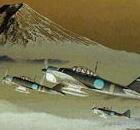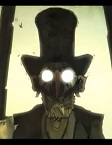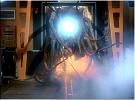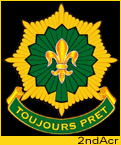RAM
Posts: 402
Joined: 5/1/2000
From: Bilbao,Vizcaya,Spain
Status: offline

|
also, there are many ways for a less nimble fighter on the tail of a highly maneouverable one to follow it into a sharp turn...high and low yoyos, Slicebacks, etc.
Also, planes regarded as "highly maneouverable" had relatively low corner speeds while the "can't turn" planes had high corner speeds. This is a misconception and a very common error. PLanes aren't "highly maneouverable" or "bricks"...depending on the speed they are fighting, ALL and EVERY plane can be both "extremely maneouverable" or a Brick.
So, at low speeds what we usually call the "maneouverable" plane can turn faster and inside the "less maneouverable" plane. That's mostly because at low speeds wingloading (in fact liftloading, but that is another issue) are the most important asset for turnfighters. The lower the wingloading, the better the low-speed turn a plane has. Planes with low wing loadings had very low "corner speeds" (corner speed= speed at which a plane achieves its best turning performance, over or under that speed the plane loses turning performance, the farther from the corner speed ,the more turning performance it loses)
So, at high speeds the plane with a higher wingloading, and thus, high corner speeds, may be able to actually turn INSIDE the "more maneouverable" fighter. As long as the "less maneouverable" plane starts with an advantageous position, it can follow the "more maneouverable" one until the speeds drop under safe margins for the higher wingloading plane (and then is time to disengage).
For instance, the Fw190 was one of the best dogfighters of WW2 even while having a high wingloading. It was one of the best dogfighters because they could be used in very high-speed close encounters, starting with advantage (said that, the Fw190 was kept on BnZ and energy fighting tactics, which were the main tactics of the Luftwaffe, but IT WAS an exceptional hispeed dogfighter none the less).
With its high wingloading, great high speed controls and its extremely good roll rate the Fw190 was able to win angles to fire on almost everything as long as the fight stood well over 250mph IAS. There are a lot of accounts of Fw190s cutting into Spitfires' turns...because those turns happened at 300+ mph IAS, where the turn rate of the 190 was quite superior to that of the Spitfire. A Spit with a 190 in his tail was in serious trouble, if the speeds involved were high enough (if not, all the 190 pilot had to do is to not turn with his enemy).
When the speed dropped, the Fw190's dive gave it the chance to disengage at will from the Spitfire.
Change the words "190" for "F4F" and "Spitfire" for "Zero", and you have the reason why the americans were able to fight successfully a plane with better performances on the paper. Change again the words "190" for "F4U", and "Spitfire" for "A6M5", and you know the story...
finally, if we change "190" for "F4 Phantom" and the "Spitfire" for "MiG 17" ,you'll see that the same lessons still held true 30 years after WW2, as Randy Cunningham (among many others) proved repeatedly over the Vietnam skies.
This means that high maneouverability planes, as we think of them, are in fact good LOW SPEED fighters...which lose a lot of their maneouverability at high speed clashes...while "low maneouverability" planes, as they are called, can be extremely successfull high-speed dogfighters but mostly dead meat at low speed.
There is no absolute thing as a "very nimble" fighter and a "brick" fighter. All fighters have their own fields on their flight envelope were they are "Very nimble"...or "Bricks"...against any given foe. The Oscar was a "very nimble" fighter at low speeds but a "Brick" at high speeds. The 190 (or the P47 or P51) was "very nimble" at high speeds but powerless at low speeds.
In the end what WW2 showed was that in an one on one encounter a heavy fighter with properly light high-speed controls and good dive and zoom qualities would always prevail over lightly built, designed to turn at low speeds, enemy planes, as long as the pilot didn't let his speed go under a certain treshold. In short: it's better to be nimble at high speeds than at low speeds.
The Oscar was extremely light and an excellent low speed turner. However it couldn't fight at all at high speeds. So...results : it was dead meat against almost anything else if the "anything else" stood out of low-speed dogfights.
< Message edited by RAM -- 10/17/2004 2:06:05 PM >
_____________________________
RAM
"Look at me! look at me!!!
Not like that! NOT LIKE THAT!!!"
|
 Printable Version
Printable Version

 ). Watching innumerable combat replays without hitting esc key (sorry guys, makes turn longer but I was curious) I've noticed something strange, almost a possible reversal to the intent. Oscars are lightly armoured and armed, so I don't expect them to blow everything out of the sky...the odd outright kill, a few damaged enemy aircraft crashing on the return leg, but mainly damage to enemy planes. This I see.
). Watching innumerable combat replays without hitting esc key (sorry guys, makes turn longer but I was curious) I've noticed something strange, almost a possible reversal to the intent. Oscars are lightly armoured and armed, so I don't expect them to blow everything out of the sky...the odd outright kill, a few damaged enemy aircraft crashing on the return leg, but mainly damage to enemy planes. This I see. 







 .
.






 And yes. a direct link is there.
And yes. a direct link is there.









 Not!
Not!
 New Messages
New Messages No New Messages
No New Messages Hot Topic w/ New Messages
Hot Topic w/ New Messages Hot Topic w/o New Messages
Hot Topic w/o New Messages Locked w/ New Messages
Locked w/ New Messages Locked w/o New Messages
Locked w/o New Messages Post New Thread
Post New Thread